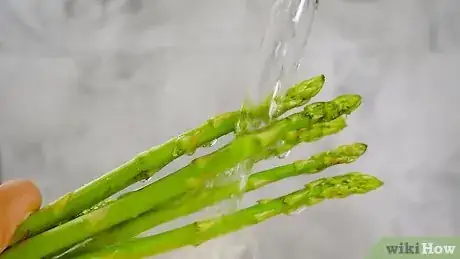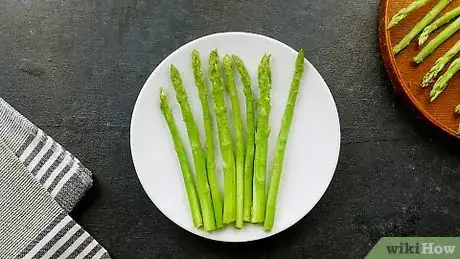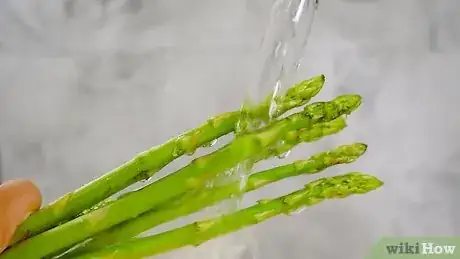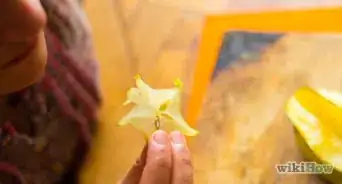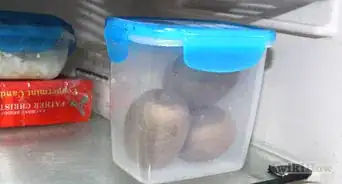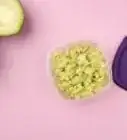This article was co-authored by wikiHow staff writer, Jessica Gibson. Jessica Gibson is a Writer and Editor who's been with wikiHow since 2014. After completing a year of art studies at the Emily Carr University in Vancouver, she graduated from Columbia College with a BA in History. Jessica also completed an MA in History from The University of Oregon in 2013.
The wikiHow Culinary Team also followed the article's instructions and verified that they work.
This article has been viewed 38,078 times.
Learn more...
Asparagus is a delicate and versatile vegetable. Unfortunately, sand and grit can become stuck in its tender tips and leaves. To clean the asparagus, rinse it well and rub away any dirt. Or lower the stalks into boiling water to release the trapped grit. You can also shave the outer peel away to remove dirt or sand that's trapped under the little leaves.
Steps
Rinsing
-
1Hold the asparagus under running water. Take a bunch of asparagus and remove the rubber band that holds the stalks together. Turn on cool water and rinse the asparagus stalks under the water. Rinse the thinnest end where sand and grit can hide really well.[1]
- If the asparagus seems very dirty, you can use your thumb and forefinger to loosen sand or grit. You can also wash the stalks individually to remove the dirt.
-
2Snap off the tough ends of the asparagus. Turn off the water and set the cleaned asparagus on a work surface. Take one asparagus stalk and hold the middle of it with one hand. Use the thumb and forefinger of your other hand to hold the tough end of the stalk. Gently bend the asparagus stalk down, so the tough end snaps off. Snap off the ends from all of the cleaned asparagus.[2]
- If you're using thick asparagus, you may need to snap off a few inches (about 5 cm) from the bottom of the stalk. Thinner asparagus may only need to be trimmed by an inch (2.5 cm).
Advertisement -
3Dry the asparagus between kitchen towels. Lay a kitchen towel open on your work surface. Spread the cleaned asparagus on the towel in a single layer. Lay another kitchen towel over the asparagus and rub it gently across the asparagus. They should dry as they roll between the 2 towels.[3]
-
4Use or store the asparagus. You can use the cleaned and trimmed asparagus immediately. Roast the asparagus in the oven, sauté them on the stove top, or toss them on the grill. You can also store the cleaned asparagus in the refrigerator for 3 to 4 days.[4]
- To store the asparagus, wrap the trimmed ends in a damp paper towel so they don't dry out. Set the asparagus bunch upright in a jar or bottle so the damp towel is in the bottom and refrigerate it.
Blanching
-
1Bring a pot of water to boil. Get out a large pot and fill it three-quarters full with water. Put a lid on the pot and set it on the stove. Turn the heat to high and bring the water to a boil.[5]
-
2Dip the asparagus in the boiling water. Use tongs to hold several asparagus stalks. Lower the asparagus into the boiling water and hold them there for a few seconds. If there are any small leaves on the stalks, they should wilt a little. Lift the asparagus out of the boiling water and continue to dip the rest of the asparagus.[6]
- The hot water should open the tender tips a little so grit washes out easily.
-
3Rinse the asparagus under cool water. Set the asparagus in a strainer or colander and set it in the sink. Run cool water over the asparagus to stop it from cooking. The cold water will also help the asparagus keep its bright color.[7]
- If you'll be coating the asparagus in oil before cooking it, consider drying the asparagus between a kitchen towel.
-
4Use the asparagus or store it in the refrigerator. Use the cleaned asparagus in your recipes. You can bake the asparagus in the oven, sauté it on the stove top, or grill them. You can also store the cleaned asparagus in the refrigerator for 3 to 4 days.[8]
- To store the asparagus, wrap the trimmed ends in a damp paper towel so they don't dry out. Place the asparagus bunch upright in a jar or bottle.
Shaving
-
1Rinse the asparagus under cold water. Gather the stalks of asparagus and hold them under the faucet. Wash the asparagus with cold water and ensure that the grit at the tender tip of the stalks is rinsed away.[9]
- If the asparagus is slick or hard to handle, you can dry it with a kitchen towel before you peel it.
-
2Use a vegetable peeler to peel the asparagus. Move the rinsed asparagus to a work surface. Take a vegetable peeler and peel each stalk from the base of the tender tip to the tough end. Avoid peeling off the tender tip that you already washed. Repeat this for all of the asparagus.[10]
- Remove only the thin, outer layer of the asparagus or you may remove too much of the stalk.
-
3Snap off the tough ends. Hold one asparagus stalk by the middle of one hand. Use the thumb and forefinger of your other hand to hold the tough end of the stalk. Press the asparagus stalk down, so the tough end snaps off where the woody end meets the tender part of the asparagus. Snap off the ends from all of the cleaned asparagus.[11]
- If you're using thick asparagus, you may need to snap off a few inches (about 5 cm) from the bottom of the stalk. Thinner asparagus may only need to be trimmed by an inch (2.5 cm).
- If a thick stalk of asparagus isn't snapping easily, you may have to move your fingers closer to the center of the stalk so several inches (5 to 7.5 cm) snap off.
-
4Use the shaved asparagus in a recipe. You can use the cleaned asparagus in recipes that call for tender asparagus. Because these stalks have been trimmed and may burn easily, you should avoid tossing them on the grill. Consider sautéing them or roasting them in the oven.[12]
- You can also refrigerate the shaved asparagus for 3 to 4 days before you use the stalks. Wrap the trimmed ends in a damp paper towel to prevent them from drying out, then set the asparagus bunch upright in a jar or bottle.
Community Q&A
-
QuestionCan I rinse asparagus in bleach water?
 Community AnswerYou can dilute 1 Tbsp unscented chlorine bleach in a gallon of water; just be sure to rinse thoroughly with clean tap water before eating.
Community AnswerYou can dilute 1 Tbsp unscented chlorine bleach in a gallon of water; just be sure to rinse thoroughly with clean tap water before eating.
Things You'll Need
Rinsed Asparagus
- Asparagus
- Kitchen towels
Blanched Asparagus
- Asparagus
- Large pot with lid
- Tongs
- Colander or strainer
Shaved Asparagus
- Asparagus
- Vegetable peeler
References
- ↑ https://www.thekitchn.com/fresh-and-tasty-how-to-buy-cle-112033
- ↑ https://www.thekitchn.com/fresh-and-tasty-how-to-buy-cle-112033
- ↑ https://www.thekitchn.com/fresh-and-tasty-how-to-buy-cle-112033
- ↑ https://www.thekitchn.com/fresh-and-tasty-how-to-buy-cle-112033
- ↑ https://food52.com/blog/6895-how-to-de-grit-asparagus
- ↑ https://food52.com/blog/6895-how-to-de-grit-asparagus
- ↑ https://food52.com/blog/6895-how-to-de-grit-asparagus
- ↑ https://food52.com/blog/6895-how-to-de-grit-asparagus
- ↑ https://food52.com/blog/6895-how-to-de-grit-asparagus
About This Article
If you want to clean asparagus, remove the rubber band from the bunch and hold the asparagus under running water. When the asparagus is clean, place it on a chopping board and snap off the tough ends. Finish by laying a towel out on your table and drying the asparagus in a single layer. To blanche your asparagus to clean it instead, bring a pot of water to a boil, then pick the asparagus up with tongs and dip them in the water for a few seconds. Finally, strain the asparagus under cold water. For tips on how to shave the asparagus with a vegetable peeler, read on!
